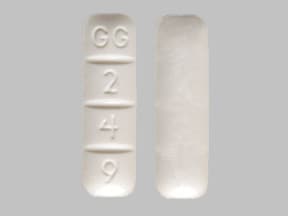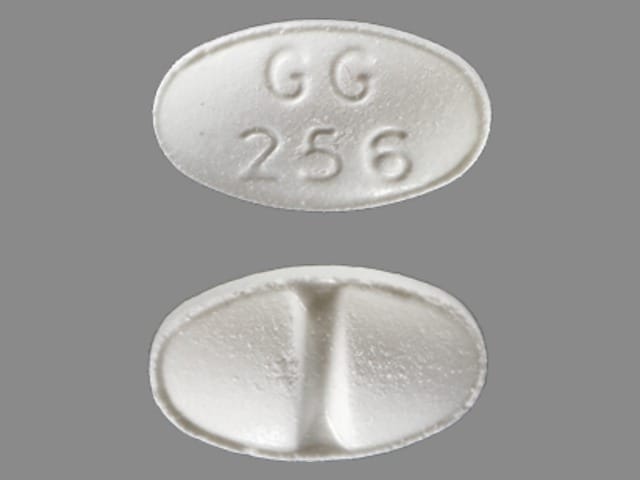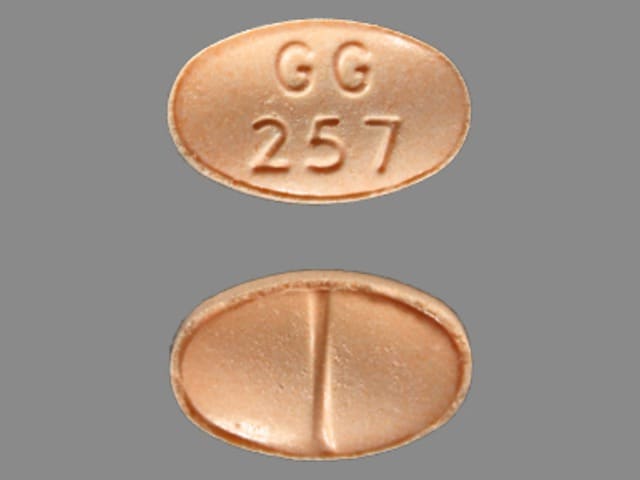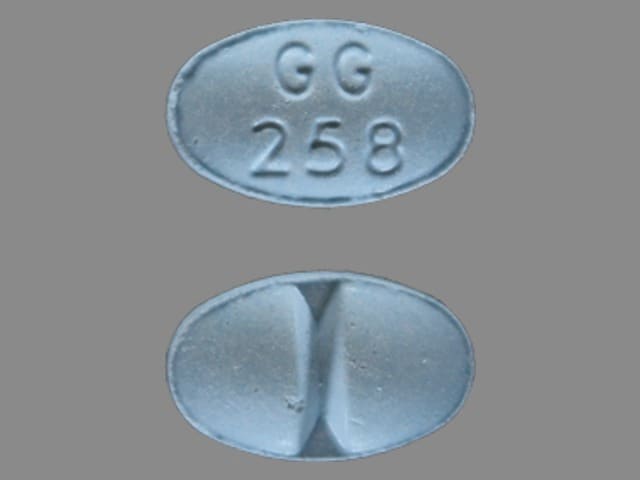Boxed Warning
Risks from concomitant use with opioids
Concomitant use of benzodiazepines and opioids may result in profound sedation, respiratory depression, coma, and death. Reserve concomitant prescribing of these drugs for use in patients for whom alternative treatment options are inadequate. Limit dosages and durations to the minimum required. Follow patients for signs and symptoms of respiratory depression and sedation.
Dosage Forms
Excipient information presented when available (limited, particularly for generics); consult specific product labeling.
Concentrate, Oral:
ALPRAZolam Intensol: 1 mg/mL (30 mL) [unflavored flavor]
Tablet, Oral:
Xanax: 0.25 mg [scored]
Xanax: 0.5 mg [scored; contains fd&c yellow #6 (sunset yellow)]
Xanax: 1 mg [scored; contains fd&c blue #2 (indigotine)]
Xanax: 2 mg [scored]
Generic: 0.25 mg, 0.5 mg, 1 mg, 2 mg
Tablet Disintegrating, Oral:
Generic: 0.25 mg, 0.5 mg, 1 mg, 2 mg
Tablet Extended Release 24 Hour, Oral:
ALPRAZolam XR: 0.5 mg
ALPRAZolam XR: 1 mg [contains fd&c yellow #10 (quinoline yellow)]
ALPRAZolam XR: 2 mg [contains fd&c blue #2 (indigotine)]
ALPRAZolam XR: 3 mg [contains fd&c blue #2 (indigotine), fd&c yellow #10 (quinoline yellow)]
Xanax XR: 0.5 mg
Xanax XR: 1 mg [contains fd&c yellow #10 (quinoline yellow)]
Xanax XR: 2 mg [contains fd&c blue #2 (indigotine)]
Xanax XR: 3 mg [contains fd&c blue #2 (indigotine), fd&c yellow #10 (quinoline yellow)]
Generic: 0.5 mg, 1 mg, 2 mg, 3 mg
Pharmacology
Mechanism of Action
Binds to stereospecific benzodiazepine receptors on the postsynaptic GABA neuron at several sites within the central nervous system, including the limbic system, reticular formation. Enhancement of the inhibitory effect of GABA on neuronal excitability results by increased neuronal membrane permeability to chloride ions. This shift in chloride ions results in hyperpolarization (a less excitable state) and stabilization. Benzodiazepine receptors and effects appear to be linked to the GABA-A receptors. Benzodiazepines do not bind to GABA-B receptors.
Pharmacokinetics/Pharmacodynamics
Absorption
Readily absorbed; Extended release: Slower relative to immediate release formulation resulting in a concentration that is maintained 5 to 11 hours after dosing; rate increased following night time dosing (versus morning dosing)
Distribution
Immediate release: Vd: 0.84 to 1.42 L/kg (Greenblatt 1993)
Metabolism
Hepatic via CYP3A4; forms two active metabolites (4-hydroxyalprazolam and α-hydroxyalprazolam [about half as active as alprazolam]) and an inactive metabolite benzophenone metabolite, however, the active metabolites are unlikely to contribute to much of the pharmacologic effects because of their low concentrations and lesser potencies.
Excretion
Urine (as unchanged drug and metabolites)
Time to Peak
Immediate release: 1 to 2 hours
Extended release: Adolescents and Adults: ~9 hours, relatively steady from 4 to 12 hours (Glue 2006); decreased by 1 hour when administered at bedtime (as compared to morning administration); decreased by 33% when administered with a high-fat meal; increased by 33% when administered ≥1 hour after a high-fat meal
Orally-disintegrating tablet: 1.5 to 2 hours; occurs ~15 minutes earlier when administered with water; increased to ~4 hours when administered with a high-fat meal
Half-Life Elimination
Adults: Mean: 11.2 hours (Immediate release range: 6.3 to 26.9 hours; Extended release range: 10.7 to 15.8 hours); Orally-disintegrating tablet: Mean: 12.5 hours (range: 7.9 to 19.2 hours)
Alcoholic liver disease: 19.7 hours (range: 5.8 to 65.3 hours)
Obesity: 21.8 hours (range: 9.9 to 40.4 hours)
Elderly: 16.3 hours (range: 9 to 26.9 hours)
Protein Binding
80%; primarily to albumin
Use in Specific Populations
Special Populations: Race
Maximal concentrations and half-life are approximately 15% and 25% higher in Asians.
Special Populations Note
Cigarette smoking: Concentrations may be reduced by up to 50% in smokers.
Use: Labeled Indications
Anxiety disorders (immediate release tablet, oral concentrate, orally-disintegrating tablets): Treatment of generalized anxiety disorder (GAD), short-term anxiety and anxiety association with depression
Panic disorder (extended-release tablets, oral solution, orally-disintegrating tablets, immediate-release tablets): Treatment of panic disorder, with or without agoraphobia
Contraindications
Hypersensitivity to alprazolam or any component of the formulation (cross-sensitivity with other benzodiazepines may exist); acute narrow-angle glaucoma; concurrent use with ketoconazole, itraconazole, or other potent CYP3A4 inhibitors.
Canadian labeling: Additional contraindications (not in US labeling): Myasthenia gravis; severe hepatic insufficiency; severe respiratory insufficiency; sleep apnea.
Dosage and Administration
Dosing: Adult
Note: Titrate dose gradually as needed and tolerated. Periodic reassessment and consideration of dosage reduction is recommended.
Anxiety disorders: Oral: Immediate release tablet, oral concentrate, orally-disintegrating tablet: Initial: 0.25 to 0.5 mg 3 times daily; titrate dose every 3 to 4 days; usual maximum: 4 mg/day. Patients requiring doses >4 mg/day should be increased cautiously.
Panic disorder: Oral:
Immediate release tablet, oral concentrate, orally-disintegrating tablet: Initial: 0.5 mg 3 times daily; titrate dose every 3 to 4 days in increments ≤1 mg/day. Mean effective dosage: 5 to 6 mg/day, in 3 or 4 divided doses; some patients may require as much as 10 mg/day.
Extended release: 0.5 to 1 mg once daily; titrate dose every 3 to 4 days in increments ≤1 mg/day (range: 3 to 6 mg/day).
Switching from immediate release to extended release: Patients may be switched to extended release tablets by taking the total daily dose of the immediate release tablets and giving it once daily using the extended release preparation.
Preoperative anxiety (off-label use): Oral: 0.5 mg 60-90 minutes before procedure (De Witte 2002)
Dose reduction: Abrupt discontinuation should be avoided. Daily dose may be decreased by 0.5 mg every 3 days; however, some patients may require a slower reduction. If withdrawal symptoms occur, resume previous dose and discontinue on a less rapid schedule.
Dosing: Geriatric
Note: Titrate gradually, if needed and tolerated. Periodic reassessment and consideration of dosage reduction is recommended.
Immediate release: Initial 0.25 mg 2 to 3 times/day
Extended release: Initial: 0.5 mg once daily
Dose reduction: Refer to adult dosing.
Dosing: Pediatric
Note: Titrate dose to effect; use lowest effective dose. The usefulness of this medication should be periodically reassessed.
Anxiety:
Children ≥7 years and Adolescents <18 years: Limited data available: Oral: Immediate release: Initial: 0.005 to 0.02 mg/kg/dose 3 times daily (Kliegman 2007); dosing based on a trial in patients 7 to 16 years of age (n=13), initial doses of 0.005 mg/kg or 0.125 mg/dose were given 3 times/day for situational anxiety and increments of 0.125 to 0.25 mg/dose were used to increase doses to maximum of 0.02 mg/kg/dose or 0.06 mg/kg/day; a range of 0.375 to 3 mg/day was needed (Pfefferbaum 1987). Another study in 17 children (8 to 17 years of age) with overanxious disorder or avoidant disorders used initial daily doses of 0.25 mg for children <40 kg and 0.5 mg for those >40 kg. The dose was titrated at 2-day intervals to a maximum of 0.04 mg/kg/day. Required doses ranged from 0.5 to 3.5 mg/day with a mean of 1.6 mg/day. Based on clinical global ratings, alprazolam appeared to be better than placebo; however, this difference was not statistically significant (Simeon 1992).
Adolescents ≥18 years: Oral: Immediate release: Initial: 0.25 to 0.5 mg 3 times daily; titrate dose upward as needed every 3 to 4 days; usual maximum daily dose: 4 mg/day. Patients requiring doses >4 mg/day should be increased cautiously. Periodic reassessment and consideration of dosage reduction is recommended.
Panic disorder: Adolescents ≥18 years: Oral:
Immediate release: Initial: 0.5 mg 3 times daily; titrate dose upward as needed every 3 to 4 days in increments ≤1 mg/day; mean dose used in controlled trials: 5 to 6 mg/day; maximum daily dose: 10 mg/day (rarely required)
Extended release: Initial: 0.5 to 1 mg once daily; titrate dose upward as needed every 3 to 4 days in increments ≤1 mg/day; usual dose: 3 to 6 mg/day; maximum daily dose: 10 mg/day (rarely required)
Switching from immediate release to extended release: Administer the same total daily dose, but give once daily; if effect is not adequate, titrate dose as above.
Premenstrual dysphoric disorder: Limited data available: Adolescents: Oral: Initial dose: 0.25 mg 3 times daily; titrate as needed. Usual daily dose: 1.25 to 2.25 mg/day (Kliegman 2011)
Discontinuation of therapy: Abrupt discontinuation should be avoided. Daily dose must be gradually decreased no more frequently than every 3 days; however, some patients may require a slower reduction. If withdrawal symptoms occur, resume previous dose and discontinue on a less rapid schedule.
Extemporaneously Prepared
Note: Commercial oral solution is available (Alprazolam Intensol™: 1 mg/mL [dye free, ethanol free, sugar free; contains propylene glycol])
A 1 mg/mL oral suspension may be made with tablets and one of three different vehicles (a 1:1 mixture of Ora-Sweet® and Ora-Plus®, a 1:1 mixture of Ora-Sweet® SF and Ora-Plus®, or a 1:4 mixture of cherry syrup with Simple Syrup, NF). Crush sixty 2 mg tablets in a mortar and reduce to a fine powder. Add 40 mL of vehicle and mix to a uniform paste; mix while adding the vehicle in incremental proportions to almost 120 mL; transfer to a calibrated bottle, rinse mortar with vehicle, and add a quantity of vehicle sufficient to make 120 mL. Label "shake well" and "refrigerate". Stable for 60 days.
Nahata MC, Pai VB, and Hipple TF, Pediatric Drug Formulations, 5th ed, Cincinnati, OH: Harvey Whitney Books Co, 2004.
Administration
Immediate release preparations: Can be administered sublingually if oral administration is not possible; absorption and onset of effect are comparable to oral administration (Scavone 1987; Scavone 1992)
Extended release tablet: Should be taken once daily in the morning; do not crush, break, or chew.
Oral concentrate: Use only the provided calibrated dropper to withdraw the prescribed dose. Mix the dose with ≥30 mL of juice or other liquid or semi-solid foods (eg, applesauce, pudding). The prepared mixture should be administered immediately.
Orally disintegrating tablets: Using dry hands, place tablet on top of tongue and allow to disintegrate. Administration with water is not necessary.
Dietary Considerations
Orally-disintegrating tablets may contain phenylalanine.
Storage
Immediate release tablets: Store at 20°C to 25°C (68°F to 77°F).
Extended release tablets: Store at 25°C (77°F); excursions permitted to 15°C to 30°C (59°F to 86°F).
Oral concentrate: Store at 20°C to 25°C (68°F to 77°F). Protect from moisture. Discard opened bottle after 90 days.
Orally disintegrating tablet: Store at 20°C to 25°C (68°F to 77°F); excursions permitted to 15°C to 30°C (59°F to 86°F). Protect from moisture.
ALPRAZolam Images
Drug Interactions
Alcohol (Ethyl): CNS Depressants may enhance the CNS depressant effect of Alcohol (Ethyl). Monitor therapy
Alizapride: May enhance the CNS depressant effect of CNS Depressants. Monitor therapy
Aprepitant: May increase the serum concentration of CYP3A4 Substrates (High risk with Inhibitors). Monitor therapy
ARIPiprazole: CYP3A4 Inhibitors (Weak) may increase the serum concentration of ARIPiprazole. Management: Monitor for increased aripiprazole pharmacologic effects. Aripiprazole dose adjustments may or may not be required based on concomitant therapy and/or indication. Consult full interaction monograph for specific recommendations. Monitor therapy
Azelastine (Nasal): CNS Depressants may enhance the CNS depressant effect of Azelastine (Nasal). Avoid combination
Blonanserin: CNS Depressants may enhance the CNS depressant effect of Blonanserin. Consider therapy modification
Bosentan: May decrease the serum concentration of CYP3A4 Substrates (High risk with Inducers). Monitor therapy
Brexanolone: CNS Depressants may enhance the CNS depressant effect of Brexanolone. Monitor therapy
Brimonidine (Topical): May enhance the CNS depressant effect of CNS Depressants. Monitor therapy
Bromopride: May enhance the CNS depressant effect of CNS Depressants. Monitor therapy
Bromperidol: May enhance the CNS depressant effect of CNS Depressants. Avoid combination
Buprenorphine: CNS Depressants may enhance the CNS depressant effect of Buprenorphine. Management: Consider reduced doses of other CNS depressants, and avoiding such drugs in patients at high risk of buprenorphine overuse/self-injection. Initiate buprenorphine at lower doses in patients already receiving CNS depressants. Consider therapy modification
Cannabidiol: May enhance the CNS depressant effect of CNS Depressants. Monitor therapy
Cannabis: May enhance the CNS depressant effect of CNS Depressants. Monitor therapy
Chlormethiazole: May enhance the CNS depressant effect of CNS Depressants. Management: Monitor closely for evidence of excessive CNS depression. The chlormethiazole labeling states that an appropriately reduced dose should be used if such a combination must be used. Consider therapy modification
Chlorphenesin Carbamate: May enhance the adverse/toxic effect of CNS Depressants. Monitor therapy
Clofazimine: May increase the serum concentration of CYP3A4 Substrates (High risk with Inhibitors). Monitor therapy
CloZAPine: Benzodiazepines may enhance the adverse/toxic effect of CloZAPine. Management: Consider decreasing the dose of (or possibly discontinuing) benzodiazepines prior to initiating clozapine. Consider therapy modification
CNS Depressants: May enhance the adverse/toxic effect of other CNS Depressants. Monitor therapy
Conivaptan: May increase the serum concentration of CYP3A4 Substrates (High risk with Inhibitors). Avoid combination
CYP3A4 Inducers (Moderate): May decrease the serum concentration of CYP3A4 Substrates (High risk with Inducers). Monitor therapy
CYP3A4 Inducers (Strong): May increase the metabolism of CYP3A4 Substrates (High risk with Inducers). Management: Consider an alternative for one of the interacting drugs. Some combinations may be specifically contraindicated. Consult appropriate manufacturer labeling. Consider therapy modification
CYP3A4 Inhibitors (Moderate): May decrease the metabolism of CYP3A4 Substrates (High risk with Inhibitors). Monitor therapy
CYP3A4 Inhibitors (Strong): May increase the serum concentration of ALPRAZolam. Management: Consider using an alternative agent that is less likely to interact. If combined, monitor for increased therapeutic/toxic effects of alprazolam if combined with a strong CYP3A4 inhibitor. Consider therapy modification
Dabrafenib: May decrease the serum concentration of CYP3A4 Substrates (High risk with Inducers). Management: Seek alternatives to the CYP3A4 substrate when possible. If concomitant therapy cannot be avoided, monitor clinical effects of the substrate closely (particularly therapeutic effects). Consider therapy modification
Deferasirox: May decrease the serum concentration of CYP3A4 Substrates (High risk with Inducers). Monitor therapy
Dimethindene (Topical): May enhance the CNS depressant effect of CNS Depressants. Monitor therapy
Dofetilide: CYP3A4 Inhibitors (Weak) may increase the serum concentration of Dofetilide. Monitor therapy
Doxylamine: May enhance the CNS depressant effect of CNS Depressants. Management: The manufacturer of Diclegis (doxylamine/pyridoxine), intended for use in pregnancy, specifically states that use with other CNS depressants is not recommended. Monitor therapy
Dronabinol: May enhance the CNS depressant effect of CNS Depressants. Monitor therapy
Droperidol: May enhance the CNS depressant effect of CNS Depressants. Management: Consider dose reductions of droperidol or of other CNS agents (eg, opioids, barbiturates) with concomitant use. Exceptions to this monograph are discussed in further detail in separate drug interaction monographs. Consider therapy modification
Duvelisib: May increase the serum concentration of CYP3A4 Substrates (High risk with Inhibitors). Monitor therapy
Enzalutamide: May decrease the serum concentration of CYP3A4 Substrates (High risk with Inducers). Management: Concurrent use of enzalutamide with CYP3A4 substrates that have a narrow therapeutic index should be avoided. Use of enzalutamide and any other CYP3A4 substrate should be performed with caution and close monitoring. Consider therapy modification
Erdafitinib: May decrease the serum concentration of CYP3A4 Substrates (High risk with Inducers). Monitor therapy
Erdafitinib: May increase the serum concentration of CYP3A4 Substrates (High risk with Inhibitors). Monitor therapy
Erythromycin (Systemic): May increase the serum concentration of ALPRAZolam. Monitor therapy
Esketamine: May enhance the CNS depressant effect of CNS Depressants. Monitor therapy
Flibanserin: CYP3A4 Inhibitors (Weak) may increase the serum concentration of Flibanserin. Monitor therapy
Flunitrazepam: CNS Depressants may enhance the CNS depressant effect of Flunitrazepam. Consider therapy modification
FluvoxaMINE: May increase the serum concentration of ALPRAZolam. Monitor therapy
Fosaprepitant: May increase the serum concentration of CYP3A4 Substrates (High risk with Inhibitors). Monitor therapy
Fosnetupitant: May increase the serum concentration of CYP3A4 Substrates (High risk with Inhibitors). Monitor therapy
Fusidic Acid (Systemic): May increase the serum concentration of CYP3A4 Substrates (High risk with Inhibitors). Avoid combination
HYDROcodone: CNS Depressants may enhance the CNS depressant effect of HYDROcodone. Management: Avoid concomitant use of hydrocodone and benzodiazepines or other CNS depressants when possible. These agents should only be combined if alternative treatment options are inadequate. If combined, limit the dosages and duration of each drug. Consider therapy modification
HydrOXYzine: May enhance the CNS depressant effect of CNS Depressants. Monitor therapy
Idelalisib: May increase the serum concentration of CYP3A4 Substrates (High risk with Inhibitors). Avoid combination
Indinavir: May increase the serum concentration of ALPRAZolam. Avoid combination
Itraconazole: May increase the serum concentration of ALPRAZolam. Avoid combination
Ivosidenib: May decrease the serum concentration of CYP3A4 Substrates (High risk with Inducers). Monitor therapy
Kava Kava: May enhance the adverse/toxic effect of CNS Depressants. Monitor therapy
Ketoconazole (Systemic): May increase the serum concentration of ALPRAZolam. Avoid combination
Larotrectinib: May increase the serum concentration of CYP3A4 Substrates (High risk with Inhibitors). Monitor therapy
Lemborexant: CYP3A4 Inhibitors (Weak) may increase the serum concentration of Lemborexant. Management: The maximum recommended dosage of lemborexant is 5 mg, no more than once per night, when coadministered with weak CYP3A4 inhibitors. Consider therapy modification
Lemborexant: May enhance the CNS depressant effect of CNS Depressants. Management: Dosage adjustments of lemborexant and of concomitant CNS depressants may be necessary when administered together because of potentially additive CNS depressant effects. Close monitoring for CNS depressant effects is necessary. Consider therapy modification
Lofexidine: May enhance the CNS depressant effect of CNS Depressants. Management: Drugs listed as exceptions to this monograph are discussed in further detail in separate drug interaction monographs. Monitor therapy
Lomitapide: CYP3A4 Inhibitors (Weak) may increase the serum concentration of Lomitapide. Management: Patients on lomitapide 5 mg/day may continue that dose. Patients taking lomitapide 10 mg/day or more should decrease the lomitapide dose by half. The lomitapide dose may then be titrated up to a max adult dose of 30 mg/day. Consider therapy modification
Lorlatinib: May decrease the serum concentration of CYP3A4 Substrates (High risk with Inducers). Management: Avoid concurrent use of lorlatinib with any CYP3A4 substrates for which a minimal decrease in serum concentrations of the CYP3A4 substrate could lead to therapeutic failure and serious clinical consequences. Consider therapy modification
Magnesium Sulfate: May enhance the CNS depressant effect of CNS Depressants. Monitor therapy
Melatonin: May enhance the sedative effect of Benzodiazepines. Monitor therapy
Methadone: Benzodiazepines may enhance the CNS depressant effect of Methadone. Management: Clinicians should generally avoid concurrent use of methadone and benzodiazepines when possible; any combined use should be undertaken with extra caution. Consider therapy modification
Methotrimeprazine: CNS Depressants may enhance the CNS depressant effect of Methotrimeprazine. Methotrimeprazine may enhance the CNS depressant effect of CNS Depressants. Management: Reduce adult dose of CNS depressant agents by 50% with initiation of concomitant methotrimeprazine therapy. Further CNS depressant dosage adjustments should be initiated only after clinically effective methotrimeprazine dose is established. Consider therapy modification
MetyroSINE: CNS Depressants may enhance the sedative effect of MetyroSINE. Monitor therapy
MiFEPRIStone: May increase the serum concentration of CYP3A4 Substrates (High risk with Inhibitors). Management: Minimize doses of CYP3A4 substrates, and monitor for increased concentrations/toxicity, during and 2 weeks following treatment with mifepristone. Avoid cyclosporine, dihydroergotamine, ergotamine, fentanyl, pimozide, quinidine, sirolimus, and tacrolimus. Consider therapy modification
Minocycline (Systemic): May enhance the CNS depressant effect of CNS Depressants. Monitor therapy
Mitotane: May decrease the serum concentration of CYP3A4 Substrates (High risk with Inducers). Management: Doses of CYP3A4 substrates may need to be adjusted substantially when used in patients being treated with mitotane. Consider therapy modification
Nabilone: May enhance the CNS depressant effect of CNS Depressants. Monitor therapy
Netupitant: May increase the serum concentration of CYP3A4 Substrates (High risk with Inhibitors). Monitor therapy
NiMODipine: CYP3A4 Inhibitors (Weak) may increase the serum concentration of NiMODipine. Monitor therapy
OLANZapine: May enhance the adverse/toxic effect of Benzodiazepines. Management: Avoid concomitant use of parenteral benzodiazepines and IM olanzapine due to risks of additive adverse events (e.g., cardiorespiratory depression). Olanzapine prescribing information provides no specific recommendations regarding oral administration. Avoid combination
Ombitasvir, Paritaprevir, and Ritonavir: May increase the serum concentration of ALPRAZolam. Monitor therapy
Ombitasvir, Paritaprevir, Ritonavir, and Dasabuvir: May increase the serum concentration of ALPRAZolam. Monitor therapy
Opioid Agonists: CNS Depressants may enhance the CNS depressant effect of Opioid Agonists. Management: Avoid concomitant use of opioid agonists and benzodiazepines or other CNS depressants when possible. These agents should only be combined if alternative treatment options are inadequate. If combined, limit the dosages and duration of each drug. Consider therapy modification
Orphenadrine: CNS Depressants may enhance the CNS depressant effect of Orphenadrine. Avoid combination
Oxomemazine: May enhance the CNS depressant effect of CNS Depressants. Avoid combination
OxyCODONE: CNS Depressants may enhance the CNS depressant effect of OxyCODONE. Management: Avoid concomitant use of oxycodone and benzodiazepines or other CNS depressants when possible. These agents should only be combined if alternative treatment options are inadequate. If combined, limit the dosages and duration of each drug. Consider therapy modification
Palbociclib: May increase the serum concentration of CYP3A4 Substrates (High risk with Inhibitors). Monitor therapy
Paraldehyde: CNS Depressants may enhance the CNS depressant effect of Paraldehyde. Avoid combination
Perampanel: May enhance the CNS depressant effect of CNS Depressants. Management: Patients taking perampanel with any other drug that has CNS depressant activities should avoid complex and high-risk activities, particularly those such as driving that require alertness and coordination, until they have experience using the combination. Consider therapy modification
Pimozide: CYP3A4 Inhibitors (Weak) may increase the serum concentration of Pimozide. Avoid combination
Piribedil: CNS Depressants may enhance the CNS depressant effect of Piribedil. Monitor therapy
Pramipexole: CNS Depressants may enhance the sedative effect of Pramipexole. Monitor therapy
ROPINIRole: CNS Depressants may enhance the sedative effect of ROPINIRole. Monitor therapy
Rotigotine: CNS Depressants may enhance the sedative effect of Rotigotine. Monitor therapy
Rufinamide: May enhance the adverse/toxic effect of CNS Depressants. Specifically, sleepiness and dizziness may be enhanced. Monitor therapy
Sarilumab: May decrease the serum concentration of CYP3A4 Substrates (High risk with Inducers). Monitor therapy
Selective Serotonin Reuptake Inhibitors: CNS Depressants may enhance the adverse/toxic effect of Selective Serotonin Reuptake Inhibitors. Specifically, the risk of psychomotor impairment may be enhanced. Monitor therapy
Siltuximab: May decrease the serum concentration of CYP3A4 Substrates (High risk with Inducers). Monitor therapy
Simeprevir: May increase the serum concentration of CYP3A4 Substrates (High risk with Inhibitors). Monitor therapy
Sodium Oxybate: Benzodiazepines may enhance the CNS depressant effect of Sodium Oxybate. Avoid combination
Stiripentol: May increase the serum concentration of CYP3A4 Substrates (High risk with Inhibitors). Management: Use of stiripentol with CYP3A4 substrates that are considered to have a narrow therapeutic index should be avoided due to the increased risk for adverse effects and toxicity. Any CYP3A4 substrate used with stiripentol requires closer monitoring. Consider therapy modification
Suvorexant: CNS Depressants may enhance the CNS depressant effect of Suvorexant. Management: Dose reduction of suvorexant and/or any other CNS depressant may be necessary. Use of suvorexant with alcohol is not recommended, and the use of suvorexant with any other drug to treat insomnia is not recommended. Consider therapy modification
Tapentadol: May enhance the CNS depressant effect of CNS Depressants. Management: Avoid concomitant use of tapentadol and benzodiazepines or other CNS depressants when possible. These agents should only be combined if alternative treatment options are inadequate. If combined, limit the dosages and duration of each drug. Consider therapy modification
Teduglutide: May increase the serum concentration of Benzodiazepines. Monitor therapy
Tetrahydrocannabinol: May enhance the CNS depressant effect of CNS Depressants. Monitor therapy
Tetrahydrocannabinol and Cannabidiol: May enhance the CNS depressant effect of CNS Depressants. Monitor therapy
Thalidomide: CNS Depressants may enhance the CNS depressant effect of Thalidomide. Avoid combination
Theophylline Derivatives: May diminish the therapeutic effect of Benzodiazepines. Consider therapy modification
Tocilizumab: May decrease the serum concentration of CYP3A4 Substrates (High risk with Inducers). Monitor therapy
Triazolam: CYP3A4 Inhibitors (Weak) may increase the serum concentration of Triazolam. Management: Consider triazolam dose reduction in patients receiving concomitant weak CYP3A4 inhibitors. Consider therapy modification
Trimeprazine: May enhance the CNS depressant effect of CNS Depressants. Monitor therapy
Ubrogepant: CYP3A4 Inhibitors (Weak) may increase the serum concentration of Ubrogepant. Management: In patients taking weak CYP3A4 inhibitors, the initial and second dose (if needed) of ubrogepant should be limited to 50 mg. Consider therapy modification
Yohimbine: May diminish the therapeutic effect of Antianxiety Agents. Monitor therapy
Zolpidem: CNS Depressants may enhance the CNS depressant effect of Zolpidem. Management: Reduce the Intermezzo brand sublingual zolpidem adult dose to 1.75 mg for men who are also receiving other CNS depressants. No such dose change is recommended for women. Avoid use with other CNS depressants at bedtime; avoid use with alcohol. Consider therapy modification
Adverse Reactions
>10%:
Central nervous system: Drowsiness (immediate-release: 41% to 77%; extended-release: 23%), fatigue (immediate-release: 49%; extended-release: 14%), sedation (extended-release: 45%), ataxia (immediate-release: 40%; extended-release: 7% to 9%), memory impairment (immediate-release: 33%; extended-release: 15%), irritability (immediate-release: 33%; extended-release: ≥1%), cognitive dysfunction (immediate-release: 29%), dysarthria (immediate-release: 23%; extended-release: 11%), dizziness (immediate-release: 2% to 21%; extended-release: ≥1%), depression (extended-release: 1% to 12%)
Dermatologic: Skin rash (immediate-release: 11%; extended-release: <1%)
Endocrine & metabolic: Weight gain (immediate-release: 27%; extended-release: 5%), weight loss (immediate-release: 23%), decreased libido (6% to 14%)
Gastrointestinal: Increased appetite (immediate-release: 33%; extended-release: 7%), decreased appetite (immediate-release: 28%), constipation (immediate-release: 26%; extended-release: 8%), xerostomia (immediate-release: 15%)
Genitourinary: Difficulty in micturition (immediate-release: 12%; extended-release: ≥1%)
1% to 10%:
Cardiovascular: Hypotension (immediate-release: 5%; extended-release: <1%), chest pain (extended-release: ≥1%), palpitations (extended-release: ≥1%)
Central nervous system: Confusion (immediate-release: 10%; extended-release: 2%), altered mental status (extended-release: 7%), disinhibition (immediate-release: 3%), disturbance in attention (extended-release: 3%), equilibrium disturbance (extended-release: 3%), akathisia (immediate-release: 2%), disorientation (extended-release: 2%), lethargy (extended-release: 2%), talkativeness (immediate-release: 2%), derealization (≥1% to 2%), agitation (extended-release: ≥1%), depersonalization (extended-release: ≥1%), headache (extended-release: ≥1%), insomnia (extended-release: ≥1%), malaise (extended-release: ≥1%), nervousness (extended-release: ≥1%), nightmares (extended-release: ≥1%), restlessness (≥1%), vertigo (extended-release: ≥1%), anxiety (extended-release: 1%), feeling hot (immediate-release: 1%; extended-release: <1%), hypersomnia (extended-release: 1%), hypoesthesia (extended-release: 1%), dystonia
Dermatologic: Allergic skin reaction (≤4%), dermatitis (immediate-release: ≤4%), diaphoresis (extended-release: ≥1%), pruritus (extended-release: 1%)
Endocrine & metabolic: Menstrual disease (immediate-release: 10%; extended-release: 2%), increased libido (immediate-release: 8%; extended-release: ≥1%), change in libido (immediate-release: 7%), hot flash (extended-release: 2%)
Gastrointestinal: Nausea (extended-release: 6%), sialorrhea (immediate-release: 4% to 6%; extended-release: ≥1%), anorexia (extended-release: 2%), abdominal pain (extended-release: ≥1%), diarrhea (extended-release: ≥1%), dyspepsia (extended-release: ≥1%), vomiting (extended-release: ≥1%)
Genitourinary: Sexual disorder (immediate-release: 7%; extended-release: 2%), dysmenorrhea (extended-release: 4%), urinary incontinence (immediate-release: 2%; extended-release: <1%)
Neuromuscular & skeletal: Arthralgia (extended-release: 2%), dyskinesia (extended-release: 2%), myalgia (extended-release: 2%), back pain (extended-release: ≥1%), muscle cramps (extended-release: ≥1%), muscle twitching (extended-release: ≥1%), tremor (extended-release: ≥1%), weakness (extended-release: ≥1%), limb pain (extended-release: 1%)
Ophthalmic: Blurred vision (extended-release: ≥1%)
Respiratory: Dyspnea (extended-release: 2%), hyperventilation (extended-release: ≥1%), nasal congestion (extended-release: ≥1%), allergic rhinitis (extended-release: 1%)
Frequency not defined:
Central nervous system: Drug dependence, drug withdrawal
<1%, postmarketing, and/or case reports: Abnormal dreams, aggressive behavior, amnesia, angioedema, apathy, chest tightness, choking sensation, clumsiness, cold and clammy skin, diplopia, dysgeusia, dysphagia, edema, emotional lability, epistaxis, euphoria, falling, fever, galactorrhea, gastrointestinal disease, gynecomastia, hallucination, hangover effect, hepatic failure, hepatitis, homicidal ideation, hyperprolactinemia, hypomania, hypotonia, impaired consciousness, impulse control disorder, increased energy, increased liver enzymes, increased serum bilirubin, increased thirst, intoxicated feeling, jaundice, jitteriness, mania, mydriasis, otalgia, outbursts of anger, paraplegia, peripheral edema, photophobia, psychomotor retardation, relaxation, rhinorrhea, rigors, seizure, sensation of cold, sinus tachycardia, skin photosensitivity, sleep apnea, sleep talking, Stevens-Johnson syndrome, stupor, suicidal ideation, syncope, tinnitus, urinary frequency, urticaria, voice disorder
Warnings/Precautions
Concerns related to adverse effects:
- Anterograde amnesia: Benzodiazepines have been associated with anterograde amnesia (Nelson 1999).
- CNS depression: May cause CNS depression, which may impair physical or mental abilities; patients must be cautioned about performing tasks which require mental alertness (eg, operating machinery or driving).
- Paradoxical reactions: Paradoxical reactions, including hyperactive or aggressive behavior, have been reported with benzodiazepines; risk may be increased in adolescent/pediatric patients, geriatric patients, or patients with a history of alcohol use disorder or psychiatric/personality disorders (Mancuso 2004).
- Sleep-related activities: Hazardous sleep-related activities such as sleep-driving, cooking and eating food, and making phone calls while asleep have been noted with benzodiazepines (Dolder 2008).
Disease-related concerns:
- Depression: Use caution in patients with depression, particularly if suicidal risk may be present; episodes of mania or hypomania have occurred in depressed patients treated with alprazolam.
- Drug abuse: Use with caution in patients with a history of drug abuse or acute alcoholism; potential for drug dependency exists. Tolerance, psychological and physical dependence may occur with prolonged use (generally >10 days).
- Hepatic impairment: Use with caution in patients with hepatic impairment.
- Renal impairment: Use with caution in patients with renal impairment or predisposition to urate nephropathy; has weak uricosuric properties.
- Respiratory disease: Use with caution in patients with respiratory disease.
Concurrent drug therapy issues:
- Concomitant use with CYP inhibitors: Use with caution in patients taking strong CYP3A4 inhibitors, moderate or strong CYP3A4 inducers and major CYP3A4 substrates (see Drug Interactions); consider alternative agents that avoid or lessen the potential for CYP-mediated interactions.
- Concomitant use with opioids: [US Boxed warning]: Concomitant use of benzodiazepines and opioids may result in profound sedation, respiratory depression, coma, and death. Reserve concomitant prescribing of these drugs for use in patients for whom alternative treatment options are inadequate. Limit dosages and durations to the minimum required. Follow patients for signs and symptoms of respiratory depression and sedation.
- Drug-drug interactions: Potentially significant interactions may exist, requiring dose or frequency adjustment, additional monitoring, and/or selection of alternative therapy. Consult drug interactions database for more detailed information.
Special populations:
- Debilitated patients: Use with caution in debilitated patients; use lower starting dose.
- Elderly patients: Elderly patients may be at an increased risk of death with use; risk has been found highest within the first 4 months of use in elderly dementia patients (Jennum 2015; Saarelainen 2018).
- Fall risk: Use with extreme caution in patients who are at risk of falls; benzodiazepines have been associated with falls and traumatic injury (Nelson 1999).
- Obese patients: Use with caution in obese patients; may have prolonged action when discontinued.
- Smokers: Cigarette smoking may decrease alprazolam concentrations up to 50%.
Other warnings/precautions:
- Appropriate use: Does not have analgesic, antidepressant, or antipsychotic properties.
- Breakthrough anxiety: At the end of dosing interval, breakthrough anxiety may occur.
- Tolerance: Alprazolam has a short half-life for a benzodiazepine and the duration of action after a single dose is determined by redistribution rather than metabolism. Tolerance does not develop to the anxiolytic effects (Vinkers 2012). Chronic use of this agent may increase the perioperative benzodiazepine dose needed to achieve desired effect.
- Withdrawal: Rebound or withdrawal symptoms, including seizures, may occur following abrupt discontinuation or large decreases in dose (more common in adult patients receiving >4 mg/day or prolonged treatment); the risk of seizures appears to be greatest 24 to 72 hours following discontinuation of therapy. Use caution when reducing dose or withdrawing therapy; decrease slowly (eg, ≤0.5 mg every 3 days in adults) and monitor for withdrawal symptoms. Flumazenil may cause withdrawal in patients receiving long-term benzodiazepine therapy.
Monitoring Parameters
Respiratory and cardiovascular status
Pregnancy
Pregnancy Risk Factor
D
Pregnancy Considerations
Benzodiazepines have the potential to cause harm to the fetus. Alprazolam and its metabolites cross the human placenta. Teratogenic effects have been observed with some benzodiazepines; however, additional studies are needed. The incidence of premature birth and low birth weights may be increased following maternal use of benzodiazepines; hypoglycemia and respiratory problems in the neonate may occur following exposure late in pregnancy. Neonatal withdrawal symptoms may occur within days to weeks after birth and “floppy infant syndrome” (which also includes withdrawal symptoms) has been reported with some benzodiazepines (Bergman 1992; Iqbal 2002; Wikner 2007). When treating pregnant females with panic disorder, psychosocial interventions should be considered prior to pharmacotherapy (APA 2009). If a benzodiazepine is needed in pregnancy, agents other than alprazolam are preferred (Larsen 2015).
Patient Education
What is this drug used for?
- It is used to treat anxiety.
- It is used to treat panic attacks.
Frequently reported side effects of this drug
- Dry mouth
- Increased hunger
- Lack of appetite
- Nausea
- Constipation
- Sexual dysfunction
- Decreased sex drive
- Weight change
Other side effects of this drug: Talk with your doctor right away if you have any of these signs of:
- Depression like thoughts of suicide, anxiety, emotional instability, or confusion.
- Severe fatigue
- Shortness of breath
- Severe dizziness
- Passing out
- Change in balance
- Confusion
- Trouble with memory
- Difficulty speaking
- Menstrual changes
- Difficult urination
- Signs of a significant reaction like wheezing; chest tightness; fever; itching; bad cough; blue skin color; seizures; or swelling of face, lips, tongue, or throat.
Note: This is not a comprehensive list of all side effects. Talk to your doctor if you have questions.
Consumer Information Use and Disclaimer: This information should not be used to decide whether or not to take this medicine or any other medicine. Only the healthcare provider has the knowledge and training to decide which medicines are right for a specific patient. This information does not endorse any medicine as safe, effective, or approved for treating any patient or health condition. This is only a brief summary of general information about this medicine. It does NOT include all information about the possible uses, directions, warnings, precautions, interactions, adverse effects, or risks that may apply to this medicine. This information is not specific medical advice and does not replace information you receive from the healthcare provider. You must talk with the healthcare provider for complete information about the risks and benefits of using this medicine.










